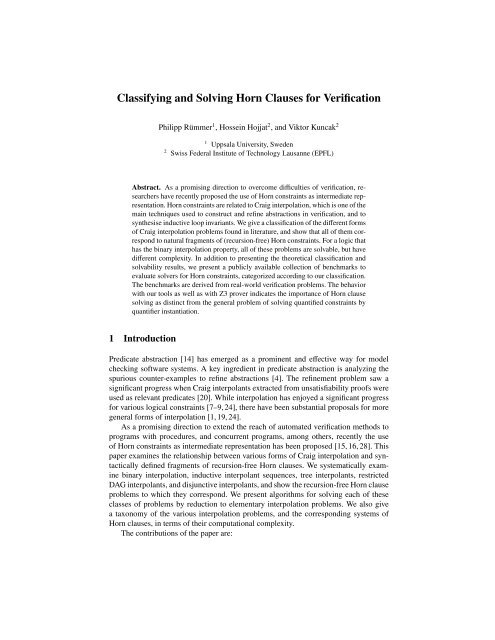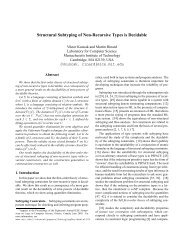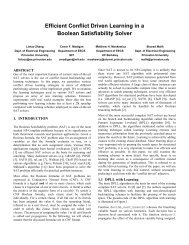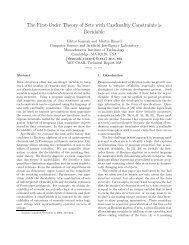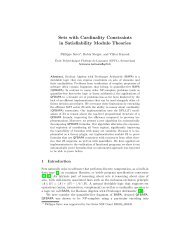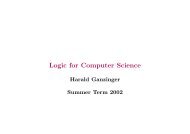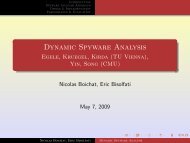Classifying and Solving Horn Clauses for Verification - Lab for ...
Classifying and Solving Horn Clauses for Verification - Lab for ...
Classifying and Solving Horn Clauses for Verification - Lab for ...
Create successful ePaper yourself
Turn your PDF publications into a flip-book with our unique Google optimized e-Paper software.
<strong>Classifying</strong> <strong>and</strong> <strong>Solving</strong> <strong>Horn</strong> <strong>Clauses</strong> <strong>for</strong> <strong>Verification</strong>Philipp Rümmer 1 , Hossein Hojjat 2 , <strong>and</strong> Viktor Kuncak 21 Uppsala University, Sweden2 Swiss Federal Institute of Technology Lausanne (EPFL)Abstract. As a promising direction to overcome difficulties of verification, researchershave recently proposed the use of <strong>Horn</strong> constraints as intermediate representation.<strong>Horn</strong> constraints are related to Craig interpolation, which is one of themain techniques used to construct <strong>and</strong> refine abstractions in verification, <strong>and</strong> tosynthesise inductive loop invariants. We give a classification of the different <strong>for</strong>msof Craig interpolation problems found in literature, <strong>and</strong> show that all of them correspondto natural fragments of (recursion-free) <strong>Horn</strong> constraints. For a logic thathas the binary interpolation property, all of these problems are solvable, but havedifferent complexity. In addition to presenting the theoretical classification <strong>and</strong>solvability results, we present a publicly available collection of benchmarks toevaluate solvers <strong>for</strong> <strong>Horn</strong> constraints, categorized according to our classification.The benchmarks are derived from real-world verification problems. The behaviorwith our tools as well as with Z3 prover indicates the importance of <strong>Horn</strong> clausesolving as distinct from the general problem of solving quantified constraints byquantifier instantiation.1 IntroductionPredicate abstraction [14] has emerged as a prominent <strong>and</strong> effective way <strong>for</strong> modelchecking software systems. A key ingredient in predicate abstraction is analyzing thespurious counter-examples to refine abstractions [4]. The refinement problem saw asignificant progress when Craig interpolants extracted from unsatisfiability proofs wereused as relevant predicates [20]. While interpolation has enjoyed a significant progress<strong>for</strong> various logical constraints [7–9,24], there have been substantial proposals <strong>for</strong> moregeneral <strong>for</strong>ms of interpolation [1, 19, 24].As a promising direction to extend the reach of automated verification methods toprograms with procedures, <strong>and</strong> concurrent programs, among others, recently the useof <strong>Horn</strong> constraints as intermediate representation has been proposed [15, 16, 28]. Thispaper examines the relationship between various <strong>for</strong>ms of Craig interpolation <strong>and</strong> syntacticallydefined fragments of recursion-free <strong>Horn</strong> clauses. We systematically examinebinary interpolation, inductive interpolant sequences, tree interpolants, restrictedDAG interpolants, <strong>and</strong> disjunctive interpolants, <strong>and</strong> show the recursion-free <strong>Horn</strong> clauseproblems to which they correspond. We present algorithms <strong>for</strong> solving each of theseclasses of problems by reduction to elementary interpolation problems. We also givea taxonomy of the various interpolation problems, <strong>and</strong> the corresponding systems of<strong>Horn</strong> clauses, in terms of their computational complexity.The contributions of the paper are:
2 Rümmer, Hojjat, Kuncak– a systematic study of relevant recursion-free <strong>Horn</strong> fragments, their relationship to<strong>for</strong>ms of Craig interpolation, <strong>and</strong> their computational complexity;– a library of recursion-free <strong>Horn</strong> problems, designed <strong>for</strong> benchmarking <strong>Horn</strong> solvers<strong>and</strong> interpolation engines;– the generalisation of our results from recursion-free <strong>Horn</strong> clauses to general wellfoundedconstraints, i.e., to constraints without infinite resolution proofs.Organisation. Related work is surveyed in Sect. 2, following in Sect. 3 by an exampleof (recursive) <strong>Horn</strong> clauses. Sect. 4 <strong>for</strong>mally introduces the concept of <strong>Horn</strong> clauses.Sect. 5 investigates the relationship between <strong>Horn</strong> fragments <strong>and</strong> Craig interpolation,<strong>and</strong> Sect. 6 their respective computational complexity. Sect. 7 presents our library of<strong>Horn</strong> benchmarks. Sect. 8 generalises from <strong>Horn</strong> clauses to well-founded clauses.2 Related Work<strong>Horn</strong> clauses have been used to represent analysis tasks in the context of constraint programming<strong>for</strong> a long time, <strong>for</strong> instance [29]. The authors of [16] propose <strong>Horn</strong> clauses<strong>for</strong> verification of multi-threaded programs. The underlying procedure <strong>for</strong> solving setsof recursion-free <strong>Horn</strong> clauses, over the combined theory of linear integer arithmetic<strong>and</strong> uninterpreted functions, was presented in [17], <strong>and</strong> a solver in [18]. A range of furtherapplications of <strong>Horn</strong> clauses, including inter-procedural model checking, was givenin [15]. <strong>Horn</strong> clauses are also proposed as intermediate/exchange <strong>for</strong>mat <strong>for</strong> verificationproblems in [6], <strong>and</strong> are natively supported by the SMT solver Z3 [11].There is a long line of research on Craig interpolation methods, <strong>and</strong> generalised<strong>for</strong>ms of interpolation, tailored to verification. For an overview of interpolation in thepresence of theories, we refer the reader to [8, 9]. Binary Craig interpolation <strong>for</strong> implicationsA → C goes back to [10], was carried over to conjunctions A ∧ B in [25], <strong>and</strong>generalised to inductive sequences of interpolants in [20, 27]. The concept of tree interpolation,strictly generalising inductive sequences of interpolants, is presented in thedocumentation of the interpolation engine iZ3 [24]; the computation of tree interpolantsby computing a sequence of binary interpolants is also described in [19]. RestrictedDAG interpolants [1] <strong>and</strong> disjunctive interpolants [30] are further generalisations ofinductive sequences of interpolants, designed to enable the simultaneous analysis ofmultiple counterexamples or program paths.The use of Craig interpolation <strong>for</strong> solving <strong>Horn</strong> clauses is discussed in [28], concentratingon the case of tree interpolation. Our paper extends this work by giving asystematic study of the relationship between different <strong>for</strong>ms of Craig interpolation <strong>and</strong><strong>Horn</strong> clauses, as well as general results about solvability <strong>and</strong> computational complexity,independent of any particular calculus used to per<strong>for</strong>m interpolation.Inter-procedural software model checking with interpolants has been an activearea of research <strong>for</strong> the last decade. In the context of predicate abstraction, it has beendiscussed how well-scoped invariants can be inferred [20] in the presence of functioncalls. Based on the concept of <strong>Horn</strong> clauses, a predicate abstraction-based algorithm <strong>for</strong>bottom-up construction of function summaries was presented in [15]. Generalisationsof the Impact algorithm [27] to programs with procedures are given in [19] (<strong>for</strong>mulated
<strong>Classifying</strong> <strong>and</strong> <strong>Solving</strong> <strong>Horn</strong> <strong>Clauses</strong> <strong>for</strong> <strong>Verification</strong> 3def f (n : Int )returns rec : Int =if (n > 0) {tmp = f(n−1)rec = tmp + 1} else {rec = 1}def main() {var res : Inthavoc(x: Int ≥ 0)res = f (x)assert(res == x + 1)} q 1havoc (x) ∧ x ′ ≥ 0 q 2res ′ = f (x) q 3res=x + 1resx + 1 q 4 en>0 q 5 q 6tmp ′ = f (n − 1) q 7rec ′ =tmp + 1 q 9¬(n>0) q 8rec ′ =1Fig. 1. A recursive program <strong>and</strong> its control flow graph (see Sect. 3).(1) r1(X, Res) ← true(2) r2(X’, Res) ← r1(X, Res) ∧ X’ ≥ 0(3) r3(X, Res’) ← r2(X, Res) ∧ rf(X, Res’)(4) r4(X, Res) ← r3(X, Res) ∧ Res = X + 1(5) false ← r3(X, Res) ∧ Res X + 1(6) r5(N, Rec, Tmp) ← true(7) r6(N, Rec, Tmp) ← r5(N, Rec, Tmp) ∧ N > 0(8) r7(N, Rec, Tmp’) ← r6(N, Rec, Tmp) ∧ rf(N − 1, Tmp’)(9) r8(N, Rec, Tmp) ← r5(N, Rec, Tmp) ∧ N ≤ 0(10) r9(N, Rec’, Tmp) ← r7(N, Rec, Tmp) ∧ Rec’ = Tmp + 1(11) r9(N, Rec’, Tmp) ← r8(N, Rec, Tmp) ∧ Rec’ = 1(12) rf (N, Rec) ← r9(N, Rec, Tmp)Fig. 2. The encoding of the program in Fig. 1 into a set of recursive <strong>Horn</strong> clauses.using nested word automata) <strong>and</strong> [2]. Finally, function summaries generated using interpolantshave also been used to speed up bounded model checking [31].Several other tools h<strong>and</strong>le procedures by increasingly inlining <strong>and</strong> per<strong>for</strong>ming under<strong>and</strong>/orover-approximation [22,32,33], but without the use of interpolation techniques.3 ExampleWe start with an example illustrating the use of <strong>Horn</strong> clauses to verify a recursive program.Fig. 1 shows an example of a recursive program, which is encoded as a set of(recursive) <strong>Horn</strong> constraints in Fig. 2. The encoding is done in such a way that the setof <strong>Horn</strong> constraints is satisfiable if <strong>and</strong> only if the program is safe, i.e., the assertionin function main cannot fail. We will use different subsets of the complete set of <strong>Horn</strong>constraints as examples throughout the paper.
<strong>Classifying</strong> <strong>and</strong> <strong>Solving</strong> <strong>Horn</strong> <strong>Clauses</strong> <strong>for</strong> <strong>Verification</strong> 5clauses are usually extracted from recursive clauses by means of finite unwinding; examplesare given in Sect. 5.3 <strong>and</strong> 5.5.4 Formulae <strong>and</strong> <strong>Horn</strong> <strong>Clauses</strong>Constraint languages. Throughout this paper, we assume that a first-order vocabularyof interpreted symbols has been fixed, consisting of a set F of fixed-arity functionsymbols, <strong>and</strong> a set P of fixed-arity predicate symbols. Interpretation of F <strong>and</strong> P isdetermined by a class S of structures (U, I) consisting of non-empty universe U, <strong>and</strong>a mapping I that assigns to each function in F a set-theoretic function over U, <strong>and</strong>to each predicate in P a set-theoretic relation over U. As a convention, we assumethe presence of an equation symbol “=” in P, with the usual interpretation. Given acountably infinite set X of variables, a constraint language is a set Constr of firstorder<strong>for</strong>mulae over F , P, X For example, the language of quantifier-free Presburgerarithmetic has F = {+, −, 0, 1, 2, . . .} <strong>and</strong> P = {=, ≤, |}).A constraint is called satisfiable if it holds <strong>for</strong> some structure in S <strong>and</strong> some assignmentof the variables X, otherwise unsatisfiable. We say that a set Γ ⊆ Constr ofconstraints entails a constraint φ ∈ Constr if every structure <strong>and</strong> variable assignmentthat satisfies all constraints in Γ also satisfies φ; this is denoted by Γ |= φ.fv(φ) denotes the set of free variables in constraint φ. We write φ[x 1 , . . . , x n ] to statethat a constraint contains (only) the free variables x 1 , . . . , x n , <strong>and</strong> φ[t 1 , . . . , t n ] <strong>for</strong> theresult of substituting the terms t 1 , . . . , t n <strong>for</strong> x 1 , . . . , x n . Given a constraint φ containingthe free variables x 1 , . . . , x n , we write Cl ∀ (φ) <strong>for</strong> the universal closure ∀x 1 , . . . , x n .φ.Craig interpolation is the main technique used to construct <strong>and</strong> refine abstractions insoftware model checking. A binary interpolation problem is a conjunction A ∧ B ofconstraints. A Craig interpolant is a constraint I such that A |= I <strong>and</strong> B |= ¬I, <strong>and</strong>such that fv(I) ⊆ fv(A) ∩ fv(B). The existence of an interpolant implies that A ∧ B isunsatisfiable. We say that a constraint language has the interpolation property if alsothe opposite holds: whenever A ∧ B is unsatisfiable, there is an interpolant I.4.1 <strong>Horn</strong> <strong>Clauses</strong>To define the concept of <strong>Horn</strong> clauses, we fix a set R of uninterpreted fixed-arity relationsymbols, disjoint from P <strong>and</strong> F . A <strong>Horn</strong> clause is a <strong>for</strong>mula C ∧ B 1 ∧ · · · ∧ B n → Hwhere– C is a constraint over F , P, X;– each B i is an application p(t 1 , . . . , t k ) of a relation symbol p ∈ R to first-order termsover F , X;– H is similarly either an application p(t 1 , . . . , t k ) of p ∈ R to first-order terms, or isthe constraint false.H is called the head of the clause, C∧B 1 ∧· · ·∧B n the body. In case C = true, we usuallyleave out C <strong>and</strong> just write B 1 ∧ · · · ∧ B n → H. First-order variables (from X) in a clauseare considered implicitly universally quantified; relation symbols represent set-theoretic
6 Rümmer, Hojjat, Kuncakrelations over the universe U of a structure (U, I) ∈ S. Notions like (un)satisfiability <strong>and</strong>entailment generalise straight<strong>for</strong>wardly to <strong>for</strong>mulae with relation symbols.A relation symbol assignment is a mapping sol : R → Constr that maps each n-aryrelation symbol p ∈ R to a constraint sol(p) = C p [x 1 , . . . , x n ] with n free variables. Theinstantiation sol(h) of a <strong>Horn</strong> clause h is defined by:sol ( C ∧ p 1 (¯t 1 ) ∧ · · · ∧ p n (¯t n ) → p(¯t) ) = C ∧ sol(p 1 )[¯t 1 ] ∧ · · · ∧ sol(p n )[¯t n ] → sol(p)[¯t]sol ( C ∧ p 1 (¯t 1 ) ∧ · · · ∧ p n (¯t n ) → false ) = C ∧ sol(p 1 )[¯t 1 ] ∧ · · · ∧ sol(p n )[¯t n ] → falseDefinition 1 (Solvability). Let HC be a set of <strong>Horn</strong> clauses over relation symbols R.1. HC is called semantically solvable if <strong>for</strong> every structure (U, I) ∈ S there is aninterpretation of the relation symbols R as set-theoretic relations over U such theuniversally quantified closure Cl ∀ (h) of every clause h ∈ HC holds in (U, I).2. A HC is called syntactically solvable if there is a relation symbol assignment solsuch that <strong>for</strong> every structure (U, I) ∈ S <strong>and</strong> every clause h ∈ HC it is the case thatCl ∀ (sol(h)) is satisfied.Note that, in the special case when S contains only one structure, S = {(U, I)},semantic solvability reduces to the existence of relations interpreting R that extend thestructure (U, I) in such a way to make all clauses true. In other words, <strong>Horn</strong> clausesare solvable in a structure if <strong>and</strong> only if the extension of the theory of (U, I) by relationsymbols R in the vocabulary <strong>and</strong> by given <strong>Horn</strong> clauses as axioms is consistent.A set HC of <strong>Horn</strong> clauses induces a dependence relation → HC on R, definingp → HC q if there is a <strong>Horn</strong> clause in HC that contains p in its head, <strong>and</strong> q in thebody. The set HC is called recursion-free if → HC is acyclic, <strong>and</strong> recursive otherwise.In the next sections we study the solvability problem <strong>for</strong> recursion-free <strong>Horn</strong> clauses<strong>and</strong> then show how to use such results in general <strong>Horn</strong> clause verification systems.Definition 2 (Normal Form). A set HC of <strong>Horn</strong> clauses is in normal <strong>for</strong>m [15] iff1. every relation symbol has a unique, pairwise distinct vector of arguments,2. every non-argument variable occurs in at most one clause.5 The Relationship between Craig Interpolation <strong>and</strong> <strong>Horn</strong> <strong>Clauses</strong>It has become common to work with generalised <strong>for</strong>ms of Craig interpolation, such asinductive sequences of interpolants, tree interpolants, <strong>and</strong> restricted DAG interpolants.We show that a variety of such interpolation approaches can be reduced to recursionfree<strong>Horn</strong> clauses. Recursion-free <strong>Horn</strong> clauses thus provide a general framework unifying<strong>and</strong> subsuming a number of earlier notions. As a side effect, we can <strong>for</strong>mulatea general theorem about existence of the individual kinds of interpolants in Sect. 6,applicable to any constraint language with the (binary) interpolation property.An overview of the relationship between specific <strong>for</strong>ms of interpolation <strong>and</strong> specificfragments of recursions-free <strong>Horn</strong> clauses is given in Table 1, <strong>and</strong> will be explained inmore detail in the rest of this section. Table 1 refers to the following fragments ofrecursion-free <strong>Horn</strong> clauses:
<strong>Classifying</strong> <strong>and</strong> <strong>Solving</strong> <strong>Horn</strong> <strong>Clauses</strong> <strong>for</strong> <strong>Verification</strong> 7Form of interpolationBinary interpolation [10, 25]A ∧ BInductive interpolant seq. [20, 27]T 1 ∧ T 2 ∧ · · · ∧ T nTree interpolants [19, 24]Restricted DAG interpolants [1]Disjunctive interpolants [30]Fragment of <strong>Horn</strong> clausesPair of <strong>Horn</strong> clausesA → p( ¯x), B ∧ p( ¯x) → false with { ¯x} = fv(A) ∩ fv(B)Linear tree-like <strong>Horn</strong> clausesT 1 → p 1 ( ¯x 1 ), p 1 ( ¯x 1 ) ∧ T 2 → p 2 ( ¯x 2 ), . . .with { ¯x i } = fv(T 1 , . . . , T i ) ∩ fv(T i+1 , . . . , T n )Tree-like <strong>Horn</strong> clausesLinear <strong>Horn</strong> clausesBody disjoint <strong>Horn</strong> clausesTable 1. Equivalence of interpolation problems <strong>and</strong> systems of <strong>Horn</strong> clauses.Definition 3 (<strong>Horn</strong> clause fragments). We say that a finite, recursion-free set HC of<strong>Horn</strong> clauses1. is linear if the body of each <strong>Horn</strong> clause contains at most one relation symbol,2. is body-disjoint if <strong>for</strong> each relation symbol p there is at most one clause containingp in its body; furthermore, every clause contains p at most once;3. is head-disjoint if <strong>for</strong> each relation symbol p there is at most one clause containingp in its head;4. is tree-like [17] if it is body-disjoint <strong>and</strong> head-disjoint.Theorem 1 (Interpolation <strong>and</strong> <strong>Horn</strong> clauses). For each line of Table 1 it holds that:1. an interpolation problem of the stated <strong>for</strong>m can be polynomially reduced to (syntactically)solving a set of <strong>Horn</strong> clauses, in the stated fragment;2. solving a set of <strong>Horn</strong> clauses (syntactically) in the stated fragment can be polynomiallyreduced to solving a sequence of interpolation problems of the stated <strong>for</strong>m.5.1 Binary Craig Interpolants [10, 25]The simplest <strong>for</strong>m of Craig interpolation is the derivation of a constraint I such that A |=I <strong>and</strong> I |= ¬B, <strong>and</strong> such that fv(I) ⊆ fv(A)∩fv(B). Such derivation is typically constructedby efficiently processing the proof of unsatisfiability of A ∧ B. To encode a binaryinterpolation problem into <strong>Horn</strong> clauses, we first determine the set ¯x = fv(A) ∩ fv(B) ofvariables that can possibly occur in the interpolant. We then pick a relation symbol p ofarity | ¯x|, <strong>and</strong> define two <strong>Horn</strong> clauses expressing that p( ¯x) is an interpolant:A → p( ¯x),B ∧ p( ¯x) → falseIt is clear that every syntactic solution <strong>for</strong> the two <strong>Horn</strong> clauses corresponds to an interpolantof A ∧ B.
<strong>Classifying</strong> <strong>and</strong> <strong>Solving</strong> <strong>Horn</strong> <strong>Clauses</strong> <strong>for</strong> <strong>Verification</strong> 91. <strong>for</strong> the root node v 0 ∈ V, it is the case that I(v 0 ) = false,2. <strong>for</strong> any node v ∈ V, the following entailment holds:∧φ(v) ∧ I(w) |= I(v) ,(v,w)∈E3. <strong>for</strong> any node v ∈ V, every non-logical symbol (in our case: variable) in I(v) occursboth in some <strong>for</strong>mula φ(w) <strong>for</strong> w such that E ∗ (v, w), <strong>and</strong> in some <strong>for</strong>mula φ(w ′ ) <strong>for</strong>some w ′ such that ¬E ∗ (v, w ′ ). (E ∗ is the reflexive transitive closure of E).Since the case of tree interpolants is instructive <strong>for</strong> solving recursion-free sets of<strong>Horn</strong> clauses in general, we give a result about the existence of tree interpolants. Theproof of the lemma computes tree interpolants by repeated derivation of binary interpolants;however, as <strong>for</strong> inductive sequences of interpolants, there are solvers that cancompute all <strong>for</strong>mulae of a tree interpolant simultaneously [16, 17, 24].Lemma 1. Suppose the constraint language Constr that has the interpolation property.Then a tree (V, E) with labelling function φ : V → Constr has a tree interpolant I if <strong>and</strong>only if ∧ v∈V φ(v) is unsatisfiable.Proof. “⇒” follows from the observation that every interpolant I(v) is a consequenceof the conjunction ∧ (v,w)∈E + φ(w).“⇐”: let v 1 , v 2 , . . . , v n be an inverse topological ordering of the nodes in (V, E), i.e.,an ordering such that ∀i, j. (E(v i , v j ) ⇒ i > j). We inductively construct a sequence of<strong>for</strong>mulae I 1 , I 2 , . . . , I n , such that <strong>for</strong> every i ∈ {1, . . . , n} the following properties hold:1. the following conjunction is unsatisfiable:∧{I k | k ≤ i, ∀ j. (E(v j , v k ) ⇒ j > i)} ∧ ( φ(v i+1 ) ∧ φ(v i+2 ) ∧ · · · ∧ φ(v n ) ) (1)2. the following entailment holds:∧φ(v i ) ∧(v i ,v j )∈EI j|= I i3. every non-logical symbol in I i occurs both in a <strong>for</strong>mula φ(w) with E ∗ (v i , w), <strong>and</strong> ina <strong>for</strong>mula φ(w ′ ) with ¬E ∗ (v i , w ′ ).Assume that the <strong>for</strong>mulae I 1 , I 2 , . . . , I i have been constructed, <strong>for</strong> i ∈ {0, . . . , n − 1}.We then derive the next interpolant I i+1 by solving the binary interpolation problem( ∧ )φ(vi+1 ) ∧ I j ∧E(v i+1 ,v j )( ∧{I k | k ≤ i, ∀ j. (E(v j , v k ) ⇒ j > i + 1)} ∧ φ(v i+2 ) ∧ · · · ∧ φ(v n ) ) (2)That is, we construct I i+1 so that the following entailments hold:∧φ(v i+1 ) ∧ I j |= I i+1 ,E(v i+1 ,v j )∧{I k | k ≤ i, ∀ j. (E(v j , v k ) ⇒ j > i + 1)} ∧ φ(v i+2 ) ∧ · · · ∧ φ(v n ) |= ¬I i+1
10 Rümmer, Hojjat, KuncakFurthermore, I i+1 only contains non-logical symbols that are common to the left <strong>and</strong> theright side of the conjunction.Note that (2) is equivalent to (1), there<strong>for</strong>e unsatisfiable, <strong>and</strong> a well-<strong>for</strong>med interpolationproblem. It is also easy to see that the properties 1–3 hold <strong>for</strong> I i+1 . Also, we caneasily verify that the labelling function I : v i ↦→ I i is a solution <strong>for</strong> the tree interpolationproblem defined by (V, E) <strong>and</strong> φ.⊓⊔Tree interpolation as tree-like <strong>Horn</strong> clauses. The encoding of a tree interpolation problemas a tree-like set of <strong>Horn</strong> clauses is very similar to the encoding <strong>for</strong> inductive sequencesof interpolants. We introduce a fresh relation symbol p v <strong>for</strong> each node v ∈ Vof a tree interpolation problem (V, E), φ, assuming that <strong>for</strong> each v ∈ V the vector ¯x v =⋃E ∗ (v,w) fv(φ(w)) ∩ ⋃ ¬E ∗ (v,w) fv(φ(w)) represents the set of variables that can occur in theinterpolant I(v). The interpolation problem is then represented by the following clauses:{ ∧p 0 ( ¯x 0 ) → false, φ(v) ∧ p w ( ¯x w ) → p v ( ¯x v ) } v∈V(v,w)∈ETree-like <strong>Horn</strong> clauses as tree interpolation. Suppose HC is a finite, recursion-free, <strong>and</strong>tree-like set of <strong>Horn</strong> clauses. We can solve the system of <strong>Horn</strong> clauses by computing atree interpolant <strong>for</strong> every connected component of the → HC -graph. As be<strong>for</strong>e, we firstnormalise the <strong>Horn</strong> clauses according to Def. 2. The interpolation graph (V, E) is thendefined by choosing the set V = R ∪ {false} of relation symbols as nodes, <strong>and</strong> the childrelation E(p, q) to hold whenever p occurs as head, <strong>and</strong> q within the body of a clause.The labelling function φ is defined by φ(p) = C whenever there is a clause with headsymbol p <strong>and</strong> constraint C, <strong>and</strong> φ(p) = false if p does not occur as head of any clause.Example 1. We consider a subset of the <strong>Horn</strong> clauses given in Fig. 2:(1) r1(X, Res) ← true(2) r2(X’, Res) ← r1(X, Res) ∧ X’ ≥ 0(3) r3(X, Res’) ← r2(X, Res) ∧ rf(X, Res’)(5) false ← r3(X, Res) ∧ Res X + 1(6) r5(N, Rec, Tmp) ← true(9) r8(N, Rec, Tmp) ← r5(N, Rec, Tmp) ∧ N ≤ 0(11) r9(N, Rec’, Tmp) ← r8(N, Rec, Tmp) ∧ Rec’ = 1(12) rf (N, Rec) ← r9(N, Rec, Tmp)Note that this recursion-free subset of the clauses is body-disjoint <strong>and</strong> head-disjoint,<strong>and</strong> thus tree-like. Since the complete set of clauses in Fig. 2 is solvable, also any subsetis; in order to compute a (syntactic) solution of the clauses, we set up the correspondingtree interpolation problem. Fig. 4 shows the tree with the labelling φ to be interpolated(in grey), as well as the head literals of the clauses generating the nodes of the tree.A tree interpolant solving the interpolation problem is given in Fig. 5. The tree interpolantcan be mapped to a solution of the original tree-like <strong>Horn</strong>, <strong>for</strong> instance we setr 8 (n 8 , rec 8 , tmp 8 ) = (n 8 ≤ 0) <strong>and</strong> r 9 (n 9 , rec 9 , tmp 9 ) = (n 9 ≤ −1 ∨ (rec 9 = 1 ∧ n 9 = 0)).Symmetric Interpolants A special case of tree interpolants, symmetric interpolants,was introduced in [26]. Symmetric interpolants are equivalent to tree interpolants with
<strong>Classifying</strong> <strong>and</strong> <strong>Solving</strong> <strong>Horn</strong> <strong>Clauses</strong> <strong>for</strong> <strong>Verification</strong> 11r 5 (n 5 , rec 5 , tmp 5 ):truer 8 (n 8 , rec 8 , tmp 8 ):n 8 = n 5 ∧ n 8 ≤ 0 ∧ rec 8 = rec 5 ∧ tmp 8 = tmp 5r 1 (x 1 , res 1 ):truer 9 (n 9 , rec 9 , tmp 9 ):n 9 = n 8 ∧ rec 9 = 1 ∧ tmp 9 = tmp 8r 2 (x 2 , res 2 ):x 2 ≥ 0 ∧ res 2 = res 1r f (n f , rec f ):n f = n 9 ∧ rec f = rec 9r 3 (x 3 , res 3 ):x 3 = x 2 ∧ x 3 = n f ∧ res 3 = rec ffalse:res 3 x 3 + 1Fig. 4. Tree interpolation problem <strong>for</strong> the clauses in Example 1a flat tree structure (V, E), i.e., V = {root, v 1 , . . . , v n }, where the nodes v 1 , . . . , v n are thedirect children of root.5.4 Restricted (<strong>and</strong> Unrestricted) DAG Interpolants [1]Restricted DAG interpolants are a further generalisation of inductive sequence of interpolants,introduced <strong>for</strong> the purpose of reasoning about multiple paths in a program simultaneously[1]. Suppose (V, E, en, ex) is a finite connected DAG with entry node en ∈V <strong>and</strong> exit node ex ∈ V, further L E : E → Constr a labelling of edges with constraints,<strong>and</strong> L V : V → Constr a labelling of vertices. A restricted DAG interpolant is a mappingI : V → Constr with1. I(en) = true, I(ex) = false,2. <strong>for</strong> all (v, w) ∈ E the entailment I(v) ∧ L V (v) ∧ L E (v, w) |= I(w) ∧ L V (w) holds, <strong>and</strong>3. <strong>for</strong> all v ∈ V it is the case that 4fv(I(v)) ⊆ ( ⋃fv(L E (a, v)) ) ∩ ( ⋃fv(L E (v, a)) ) .(a,v)∈E(v,a)∈E4 The definition of DAG interpolants in [1, Def. 4] implies that fv(I(v)) = ∅ <strong>for</strong> every interpolantI(v), v ∈ V, i.e., only trivial interpolants are allowed. We assume that this is a mistakein [1, Def. 4], <strong>and</strong> corrected the definition as shown here.
12 Rümmer, Hojjat, Kuncaktruen 8 ≤ 0n 9 ≤ −1 ∨ (rec 9 = 1 ∧ n 9 = 0)x 2 ≥ 0n f ≤ −1 ∨ (rec f = 1 ∧ n f = 0)res 3 = x 3 + 1falseFig. 5. Tree interpolant solving the interpolation problem in Fig. 4The UFO verification system [3] is able to compute DAG interpolants, based onthe interpolation functionality of MathSAT [9]. We can observe that DAG interpolants(despite their name) are incomparable in expressiveness to tree interpolation. This isbecause DAG interpolants correspond to linear <strong>Horn</strong> clauses, <strong>and</strong> might have sharedrelation symbol in bodies, while tree interpolants correspond to possibly nonlinear treelike<strong>Horn</strong> clauses, but do not allow shared relation symbols in bodies.Encoding of restricted DAG interpolants as linear <strong>Horn</strong> clauses. For every v ∈ V, let{ ¯x v } = ( ⋃fv(L E (a, v)) ) ∩ ( ⋃fv(L E (v, a)) )(a,v)∈E(v,a)∈Ebe the variables allowed in the interpolant to be computed <strong>for</strong> v, <strong>and</strong> p v be a freshrelation symbol of arity | ¯x v |. The interpolation problem is then defined by the followingset of linear <strong>Horn</strong> clauses:For each (v, w) ∈ E: L V (v) ∧ L E (v, w) ∧ p v ( ¯x v ) → p w ( ¯x w ),L V (v) ∧ ¬L V (w) ∧ L E (v, w) ∧ p v ( ¯x v ) → false,For en, ex ∈ V: true → p en ( ¯x en ), p ex ( ¯x ex ) → falseEncoding of linear <strong>Horn</strong> clauses as DAG interpolants. Suppose HC is a finite, recursionfree,<strong>and</strong> linear set of <strong>Horn</strong> clauses. We can solve the system of <strong>Horn</strong> clauses by computinga DAG interpolant <strong>for</strong> every connected component of the → HC -graph. As inSect. 5.2, we normalise <strong>Horn</strong> clauses according to Def. 2. We also assume that multipleclauses C ∧ p( ¯x p ) → q( ¯x q ) <strong>and</strong> D ∧ p( ¯x p ) → q( ¯x q ) with the same relation symbols aremerged to (C ∨ D) ∧ p( ¯x p ) → q( ¯x q ).Let {p 1 , . . . , p n } be all relation symbols of one connected component. We then definethe DAG interpolation problem (V, E, en, ex), L E , L V by
<strong>Classifying</strong> <strong>and</strong> <strong>Solving</strong> <strong>Horn</strong> <strong>Clauses</strong> <strong>for</strong> <strong>Verification</strong> 13– the vertices V = {p 1 , . . . , p n } ∪ {en, ex}, including two fresh nodes en, ex,– the edge relationE ={(p, q) | there is a clause C ∧ p( ¯x p ) → q( ¯x q ) ∈ HC}∪ {(en, p) | there is a clause D → p( ¯x p ) ∈ HC}∪ {(p, ex) | there is a clause E ∧ p( ¯x p ) → false ∈ HC} ,– <strong>for</strong> each (v, w) ∈ E, the edge labelling⎧C ∧ ¯x v = ¯x v ∧ ¯x w = ¯x w⎪⎨L E (v, w) = D ∧ ¯x w = ¯x w⎪⎩ E ∧ ¯x v = ¯x vif C ∧ v( ¯x v ) → w( ¯x w ) ∈ HCif v = en <strong>and</strong> D → w( ¯x w ) ∈ HCif w = ex <strong>and</strong> E ∧ v( ¯x v ) → false ∈ HCNote that the labels include equations like ¯x v = ¯x v to ensure that the right variablesare allowed to occur in interpolants.– <strong>for</strong> each v ∈ V, the node labelling L V (v) = true.By checking the definition of DAG interpolants, it can be verified that every interpolantsolving the problem (V, E, en, ex), L E , L V is also a solution of the linear <strong>Horn</strong> clauses.5.5 Disjunctive Interpolants [30]Disjunctive interpolants were introduced in [30] as a generalisation of tree interpolants.Disjunctive interpolants resemble tree interpolants in the sense that the relationship ofthe components of an interpolant is defined by a tree; in contrast to tree interpolants,however, this tree is an <strong>and</strong>/or-tree: branching in the tree can represent either conjunctionsor disjunctions. Disjunctive interpolants correspond to sets of body-disjoint <strong>Horn</strong>clauses; in this representation, <strong>and</strong>-branching is encoded by clauses with multiple bodyliterals (like with tree interpolants), while or-branching is interpreted as multiple clausessharing the same head symbol. For a detailed account on disjunctive interpolants, werefer the reader to [30].The solution of body-disjoint <strong>Horn</strong> clauses can be computed by solving a sequenceof tree-like sets of <strong>Horn</strong> clauses:Lemma 2. Let HC be a finite set of recursion-free body-disjoint <strong>Horn</strong> clauses. HChas a syntactic/semantic solution if <strong>and</strong> only if every maximum tree-like subset of HChas a syntactic/semantic solution.Proof. We outline direction “⇐” <strong>for</strong> syntactic solutions. <strong>Solving</strong> the tree-like subsets ofHC yields, <strong>for</strong> each relation symbol p ∈ R, a set SC p of solution constraints. A globalsolution of HC can be constructed by <strong>for</strong>ming a positive Boolean combination of theconstraints in SC p <strong>for</strong> each p ∈ R.⊓⊔Example 2. We consider a recursion-free unwinding of the <strong>Horn</strong> clauses in Fig. 2. Tomake the set of clauses body-disjoint, the clauses (6), (9), (11), (12) were duplicated,introducing primed copies of all relation symbols involved. The clauses are not headdisjoint,since (10) <strong>and</strong> (11) share the same head symbol:
14 Rümmer, Hojjat, Kuncak(1) r1(X, Res) ← true(2) r2(X’, Res) ← r1(X, Res) ∧ X’ ≥ 0(3) r3(X, Res’) ← r2(X, Res) ∧ rf(X, Res’)(5) false ← r3(X, Res) ∧ Res X + 1(6) r5(N, Rec, Tmp) ← true(7) r6(N, Rec, Tmp) ← r5’(N, Rec, Tmp) ∧ N > 0(8) r7(N, Rec, Tmp’) ← r6(N, Rec, Tmp) ∧ rf’(N − 1, Tmp’)(9) r8(N, Rec, Tmp) ← r5(N, Rec, Tmp) ∧ N ≤ 0(10) r9(N, Rec’, Tmp) ← r7(N, Rec, Tmp) ∧ Rec’ = Tmp + 1(11) r9(N, Rec’, Tmp) ← r8(N, Rec, Tmp) ∧ Rec’ = 1(12) rf (N, Rec) ← r9(N, Rec, Tmp)(6’) r5 ’( N, Rec, Tmp) ← true(6’’) r5’’(N, Rec, Tmp) ← true(9’) r8 ’( N, Rec, Tmp) ← r5’’(N, Rec, Tmp) ∧ N ≤ 0(11’) r9 ’( N, Rec’, Tmp) ← r8’(N, Rec, Tmp) ∧ Rec’ = 1(12’) rf ’( N, Rec) ← r9’(N, Rec, Tmp)There are two maximum tree-like subsets: T 1 = {(1), (2), (3), (5), (6), (9), (11), (12)},<strong>and</strong> T 2 = {(1), (2), (3), (5), (7), (8), (10), (12), (6 ′ ), (6 ′′ ), (9 ′ ), (11 ′ ), (12 ′ )}. The subset T 1has been discussed in Example 1. In the same way, it is possible to construct a solution<strong>for</strong> T 2 by solving a tree interpolation problem. The two solutions can be combined toconstruct a solution of T 1 ∪ T 2 :T 1 T 2 T 1 ∪ T 2r 1 (x, r) true true truer 2 (x, r) x ≥ 0 true x ≥ 0r 3 (x, r) r = x + 1 r = x + 1 r = x + 1r 5 (n, c, t) true true truer 6 (n, c, t) − n ≥ 1 n ≥ 1r 7 (n, c, t) − t = n t = nr 8 (n, c, t) n ≤ 0 − n ≤ 0r 9 (n, c, t) n ≤ −1 ∨ (c = 1 ∧ n = 0) c = n + 1 n ≤ −1 ∨ c = n + 1r f (n, c) n ≤ −1 ∨ (c = 1 ∧ n = 0) c = n + 1 n ≤ −1 ∨ c = n + 1r ′ 5r ′′5r ′ 8r ′ 9r ′ f(n, c, t) − true true(n, c, t) − true true(n, c, t) − n ≤ 0 n ≤ 0(n, c, t) − n ≤ −1 ∨ (c = 1 ∧ n = 0) n ≤ −1 ∨ (c = 1 ∧ n = 0)(n, c, t) − n ≤ −1 ∨ (c = 1 ∧ n = 0) n ≤ −1 ∨ (c = 1 ∧ n = 0)In particular, the disjunction of the two interpretations of r 9 (n, c, t) has to be used,in order to satisfy both (10) <strong>and</strong> (11) (similarly <strong>for</strong> r f (n, c)). In contrast, the conjunctionof the interpretations of r 2 (x, r) is needed to satisfy (3).6 The Complexity of Recursion-free <strong>Horn</strong> <strong>Clauses</strong>over Quantifier-free Presburger ArithmeticWe give an overview of the considered fragments of recursion-free <strong>Horn</strong> clauses, <strong>and</strong>the corresponding interpolation problem, in Fig. 6. The diagram also shows the com-
<strong>Classifying</strong> <strong>and</strong> <strong>Solving</strong> <strong>Horn</strong> <strong>Clauses</strong> <strong>for</strong> <strong>Verification</strong> 15(Restricted) DAG interpolationDisjunctive interpolationTree interpolationGeneral recursion-freeHead-disjointLinearBody-disjointTree-likeco-NP co-NEXPTIMEInductive interpolant sequencesLinear tree-likeBinary interpolationCraig interpolationRecursion-free <strong>Horn</strong> clausesFig. 6. Relationship between different <strong>for</strong>ms of Craig interpolation, <strong>and</strong> different fragments ofrecursion-free <strong>Horn</strong> clauses. An arrow from A to B expresses that problem A is (strictly) subsumedby B. The complexity classes “co-NP” <strong>and</strong> “co-NEXPTIME” refer to the problem ofchecking solvability of <strong>Horn</strong> clauses over quantifier-free Presburger arithmetic.plexity of deciding (semantic or syntactic) solvability of a set of <strong>Horn</strong> clauses, <strong>for</strong> <strong>Horn</strong>clauses over the constraint language of quantifier-free Presburger arithmetic. Most ofthe complexity results occur in [30], but in addition we use the following two observations:Lemma 3. Semantic solvability of recursion-free linear <strong>Horn</strong> clauses over the constraintlanguage of quantifier-free Presburger arithmetic is in co-NP.Proof. A set HC of recursion-free linear <strong>Horn</strong> clauses is solvable if <strong>and</strong> only if theexpansion exp(HC) is unsatisfiable [30]. For linear clauses, exp(HC) is a disjunction of(possibly) exponentially many <strong>for</strong>mulae, each of which is linear in the size of exp(HC).Consequently, satisfiability of exp(HC) is in NP, <strong>and</strong> unsatisfiability in co-NP. ⊓⊔Lemma 4. Semantic solvability of recursion-free head-disjoint <strong>Horn</strong> clauses over theconstraint language of quantifier-free Presburger arithmetic is co-NEXPTIME-hard.Proof. The proof given in [30] <strong>for</strong> co-NEXPTIME-hardness of recursion-free <strong>Horn</strong>clauses over quantifier-free Presburger arithmetic can be adapted to only require headdisjointclauses. This is because a single execution step of a non-deterministic Turingmachine can be expressed as quantifier-free Presburger <strong>for</strong>mula.⊓⊔
16 Rümmer, Hojjat, Kuncak7 Towards a Library of Interpolation BenchmarksIn order to support the development of interpolation engines, <strong>Horn</strong> solvers, <strong>and</strong> verificationsystems, we have started to collect relevant benchmarks of recursion-free <strong>Horn</strong>clauses, categorised according to the classes determined in the previous sections. 5 Thebenchmarks have been extracted from runs of the model checker Eldarica [30], whichprocesses systems of (usually recursive) <strong>Horn</strong> clauses by iteratively solving recursionfreeunwindings, as outlined in Sect. 3. For each recursive verification problem, in thisway a set of recursion-free systems of <strong>Horn</strong> clauses (of varying size) can be synthesised.The benchmarks can be used to evaluate both <strong>Horn</strong> solvers <strong>and</strong> interpolation engines,according to the correspondence in Fig. 6.At the moment, our benchmarks are extracted from the verification problems in [30],<strong>and</strong> <strong>for</strong>mulated over the constraint language of linear integer arithmetic; in the future, itis planned to also include other constraint languages, including rational arithmetic <strong>and</strong>the theory of arrays. The benchmarks are stored in SMT-LIB 2 <strong>for</strong>mat [5]. All of thebenchmarks can be solved by Eldarica, <strong>and</strong> by the <strong>Horn</strong> solving engine in Z3 [21].8 From Recursion-free <strong>Horn</strong> <strong>Clauses</strong> to Well-founded <strong>Clauses</strong>It is natural to ask whether the considerations of the last sections also apply to clausesthat are not <strong>Horn</strong> clauses (i.e., clauses that can contain multiple positive literals), providedthe clauses are “recursion-free.” Is it possible, like <strong>for</strong> <strong>Horn</strong> clauses, to derivesolutions of recursion-free clauses by computing Craig interpolants?To investigate the situation <strong>for</strong> clauses that are not <strong>Horn</strong>, we first have to generalisethe concept of clauses being recursion-free: the definition provided in Sect. 4, <strong>for</strong>mulatedwith the help of the dependence relation → HC , only applies to <strong>Horn</strong> clauses. Fornon-<strong>Horn</strong> clauses, we instead choose to reason about the absence of infinite propositionalresolution derivations. Because the proposed algorithms [30] <strong>for</strong> solving recursionfreesets of <strong>Horn</strong> clauses all make use of exhaustive expansion or inlining, i.e., the constructionof all derivations <strong>for</strong> a given set of clauses, the requirement that no infinitederivations exist is fundamental. 6Somewhat surprisingly, we observe that all sets of clauses without infinite derivationshave the shape of <strong>Horn</strong> clauses, up to renaming of relation symbols. This meansthat procedures h<strong>and</strong>ling <strong>Horn</strong> clauses cover all situations in which we can hope tocompute solutions with the help of Craig interpolation.Since constraints <strong>and</strong> relation symbol arguments are irrelevant <strong>for</strong> this observation,the following results are entirely <strong>for</strong>mulated on the level of propositional logic:5 http://lara.epfl.ch/w/horn-nonrec-benchmarkshttps://svn.sosy-lab.org/software/sv-benchmarks/trunk/clauses/LIA/Eldarica/6 We do not take subsumption between clauses, or loops in derivations into account. This meansthat a set of clauses might give rise to infinite derivations even if the set of derived clauses isfinite. It is conceivable that notions of subsumption, or more generally the application of terminatingsaturation strategies [13], can be used to identify more general fragments of clauses<strong>for</strong> which syntactic solutions can effectively be computed. This line of research is future work.
<strong>Classifying</strong> <strong>and</strong> <strong>Solving</strong> <strong>Horn</strong> <strong>Clauses</strong> <strong>for</strong> <strong>Verification</strong> 17– a propositional literal is either a Boolean variable p, q, r (positive literals), or thenegation ¬p, ¬q, ¬r of a Boolean variable (negative literals).– a propositional clause is a disjunction p ∨ ¬q ∨ p of literals. The multiplicity of aliteral is important, i.e., clauses could alternatively be represented as multi-sets ofliterals.– a <strong>Horn</strong> clause is a clause that contains at most one positive literal.– given a set HC of <strong>Horn</strong> clauses, we define the dependence relation → HC on Booleanvariables by setting p → HC q if <strong>and</strong> only if there is a clause in HC in which poccurs positively, <strong>and</strong> q negatively (like in Sect. 4). The set HC is called recursionfreeif → HC is acyclic.We can now generalise the notion of a set of clauses being “recursion-free” to non-<strong>Horn</strong> clauses:Definition 4. A set C of propositional clauses is well-founded if there is no infinitesequence c 0 , c 1 , c 2 , c 3 , . . . of clauses with the property that– c 0 ∈ C is an input clause, <strong>and</strong>– <strong>for</strong> each i ≥ 1, the clause c i is derived by means of binary resolution from c i−1 <strong>and</strong>an input clause, using the ruleC ∨ p D ∨ ¬pC ∨ DLemma 5. A finite set HC of <strong>Horn</strong> clauses is well-founded if <strong>and</strong> only if it is recursionfree.Proof. “⇐” The acyclic dependence relation → HC induces a strict well-founded order< on Boolean variables: q → HC p implies p < q. The order < induces a wellfoundedorder ≪ on <strong>Horn</strong> clauses:(p ∨ C) ≪ (q ∨ D) ⇔ p > q or (p = q <strong>and</strong> C < ms D)C ≪ (q ∨ D) ⇔ trueC ≪ D ⇔ C < ms Dwhere C, D only contain negative literals, <strong>and</strong> < ms is the (well-founded) multi-set extensionof < [12].It is easy to see that a clause C ∨ D derived from two <strong>Horn</strong> clauses C ∨ p <strong>and</strong> D∨¬pusing the resolution rule is again <strong>Horn</strong>, <strong>and</strong> (C ∨ D) ≪ (C ∨ p) <strong>and</strong> (C ∨ D) ≪ (D∨¬p).The well-foundedness of ≪ implies that any sequence of clauses as in Def. 4 is finite.“⇒” If the dependence relation → HC has a cycle, we can directly construct a nonterminatingsequence c 0 , c 1 , c 2 , . . . of clauses.⊓⊔Definition 5 (Renamable-<strong>Horn</strong> [23]). If A is a set of Boolean variables, <strong>and</strong> C is aset of clauses, then r A (C) is the result of replacing in C every literal whose Booleanvariable is in A with its complement. C is called renamable-<strong>Horn</strong> if there is some set Aof Boolean variables such that r A (C) is <strong>Horn</strong>.Theorem 2. If a finite set C of clauses is well-founded, then it is renamable-<strong>Horn</strong>..
18 Rümmer, Hojjat, KuncakProof. Suppose C is <strong>for</strong>mulated over the (finite) set p 1 , p 2 , . . . , p n of Boolean variables.We construct a graph (V, E), with V = {p 1 , p 2 , . . . , p n , ¬p 1 , ¬p 2 , . . . , ¬p n } being the setof all possible literals, <strong>and</strong> (l, l ′ ) ∈ E if <strong>and</strong> only if there is a clause ¬l ∨ l ′ ∨ C ∈ C (thatmeans, a clause containing the literal l ′ , <strong>and</strong> the literal l with reversed sign). 7The graph (V, E) is acyclic. To see this, suppose there is a cycle l 1 , l 2 , . . . , l m , l m+1 =l 1 in (V, E). Then there are clauses c 1 , c 2 , . . . , c m ∈ C such that each c i contains the literals¬l i <strong>and</strong> l i+1 . We can then construct an infinite sequence c 1 = d 0 , d 1 , d 2 , . . . of clauses,where each d i (<strong>for</strong> i > 1) is obtained by resolving d i−1 with c (i mod m)+1 , contradicting theassumption that C is well-founded.Since (V, E) is acyclic, there is a strict total order < on V that is consistent with E,i.e., (l, l ′ ) ∈ E implies l < l ′ .Claim: if p < ¬p <strong>for</strong> every Boolean variable p ∈ {p 1 , p 2 , . . . , p n }, then C is <strong>Horn</strong>.Proof of the claim: suppose a non-<strong>Horn</strong> clause p i ∨ p j ∨ C ∈ C exists (with i j).Then (¬p i , p j ) ∈ E <strong>and</strong> (¬p j , p i ) ∈ E, <strong>and</strong> there<strong>for</strong>e ¬p i < p j <strong>and</strong> ¬p j < p i . Then also¬p i < p i or ¬p j < p j , contradicting the assumption that p < ¬p <strong>for</strong> every Booleanvariable p.In general, choose A = {p i | i ∈ {1, . . . , n}, ¬p i < p i }, <strong>and</strong> consider the set r A (C) ofclauses. The set r A (C) is <strong>Horn</strong>, since changing the sign of a Boolean variable p ∈ Ahas the effect of swapping the nodes p, ¬p in the graph (V, E). There<strong>for</strong>e, the newgraph (V, E ′ ) has to be compatible with a strict total order < such that p < ¬p <strong>for</strong>every Boolean variable p, satisfying the assumption of the claim above.⊓⊔Example 3. We consider the following set of clauses:C = {¬a ∨ s, a ∨ ¬p, p ∨ ¬b, b ∨ p ∨ r, ¬p ∨ q}By constructing all possible derivations, it can be shown that the set is well-founded.The graph (V, E), as constructed in the proof, is:sqaprb ¬b¬r¬p¬a¬qA strict total order that is compatible with the graph is:¬s¬s < ¬q < ¬r < ¬a < ¬p < b < ¬b < r < p < q < a < s7 This graph could equivalently be defined as the implication graph of the 2-sat problem introducedin [23], as a way of characterising whether a set of clauses is <strong>Horn</strong>.
<strong>Classifying</strong> <strong>and</strong> <strong>Solving</strong> <strong>Horn</strong> <strong>Clauses</strong> <strong>for</strong> <strong>Verification</strong> 19From the order we can read off that we need to rename the variables A = {s, q, r, a, p}in order to obtain a set of <strong>Horn</strong> clauses:r A (C) = {a ∨ ¬s, ¬a ∨ p, ¬p ∨ ¬b, b ∨ ¬p ∨ ¬r, p ∨ ¬q}9 ConclusionIn recent years there has been a growing interest in more general <strong>for</strong>ms of interpolation,organising <strong>for</strong>mulae in non-linear structures such as trees, hyper-trees or directedacyclic graphs. In this paper we showed that many <strong>for</strong>ms of interpolation can be definedas subclasses of recursion-free <strong>Horn</strong> clauses, provided a taxonomy of the variousfragments, <strong>and</strong> investigated computational complexity. We believe that the results arevaluable <strong>for</strong> application domains of <strong>Horn</strong> constraints, in particular in program verification<strong>and</strong> model checking.References1. A. Albarghouthi, A. Gurfinkel, <strong>and</strong> M. Chechik. Craig interpretation. In SAS, 2012.2. A. Albarghouthi, A. Gurfinkel, <strong>and</strong> M. Chechik. Whale: An interpolation-based algorithm<strong>for</strong> inter-procedural verification. In VMCAI, pages 39–55, 2012.3. A. Albarghouthi, Y. Li, A. Gurfinkel, <strong>and</strong> M. Chechik. Ufo: A framework <strong>for</strong> abstraction<strong>and</strong>interpolation-based software verification. In CAV, pages 672–678, 2012.4. T. Ball, A. Podelski, <strong>and</strong> S. K. Rajamani. Relative completeness of abstraction refinement<strong>for</strong> software model checking. In TACAS’02, volume 2280 of LNCS, page 158, 2002.5. C. Barrett, A. Stump, <strong>and</strong> C. Tinelli. C.: The smt-lib st<strong>and</strong>ard: Version 2.0. Technicalreport, 2010.6. N. Bjørner, K. McMillan, <strong>and</strong> A. Rybalchenko. Program verification as satisfiabilitymodulo theories. In SMT Workshop at IJCAR, 2012.7. M. P. Bonacina <strong>and</strong> M. Johansson. On interpolation in automated theorem proving.(submitted), 2012.8. A. Brillout, D. Kroening, P. Rümmer, <strong>and</strong> T. Wahl. An interpolating sequent calculus <strong>for</strong>quantifier-free Presburger arithmetic. Journal of Automated Reasoning, 47:341–367, 2011.9. A. Cimatti, A. Griggio, <strong>and</strong> R. Sebastiani. Efficient generation of Craig interpolants insatisfiability modulo theories. ACM Trans. Comput. Log., 12(1):7, 2010.10. W. Craig. Linear reasoning. A new <strong>for</strong>m of the Herbr<strong>and</strong>-Gentzen theorem. The Journal ofSymbolic Logic, 22(3):250–268, September 1957.11. L. de Moura <strong>and</strong> N. Bjørner. Z3: An efficient SMT solver. In TACAS, pages 337–340.Springer-Verlag, 2008.12. N. Dershowitz <strong>and</strong> Z. Manna. Proving termination with multiset orderings. Commun. ACM,22(8):465–476, 1979.13. C. Fermüller, A. Leitsch, U. Hustadt, <strong>and</strong> T. Tammet. Resolution decision procedures. InA. Robinson <strong>and</strong> A. Voronkov, editors, H<strong>and</strong>book of Automated Reasoning, chapter 25,pages 1791–1850. Elsevier, 2001.14. S. Graf <strong>and</strong> H. Saidi. Construction of abstract state graphs with PVS. In CAV, pages 72–83,1997.15. S. Grebenshchikov, N. P. Lopes, C. Popeea, <strong>and</strong> A. Rybalchenko. Synthesizing softwareverifiers from proof rules. In PLDI, 2012.16. A. Gupta, C. Popeea, <strong>and</strong> A. Rybalchenko. Predicate abstraction <strong>and</strong> refinement <strong>for</strong>verifying multi-threaded programs. In POPL, 2011.
20 Rümmer, Hojjat, Kuncak17. A. Gupta, C. Popeea, <strong>and</strong> A. Rybalchenko. <strong>Solving</strong> recursion-free <strong>Horn</strong> clauses overLI+UIF. In APLAS, pages 188–203, 2011.18. A. Gupta, C. Popeea, <strong>and</strong> A. Rybalchenko. Generalised interpolation by solvingrecursion-free horn clauses. CoRR, abs/1303.7378, 2013.19. M. Heizmann, J. Hoenicke, <strong>and</strong> A. Podelski. Nested interpolants. In POPL, 2010.20. T. A. Henzinger, R. Jhala, R. Majumdar, <strong>and</strong> K. L. McMillan. Abstractions from proofs. InPOPL, pages 232–244. ACM, 2004.21. K. Hoder <strong>and</strong> N. Bjørner. Generalized property directed reachability. In SAT, pages157–171, 2012.22. A. Lal, S. Qadeer, <strong>and</strong> S. K. Lahiri. Corral: A solver <strong>for</strong> reachability modulo theories. InCAV, 2012.23. H. R. Lewis. Renaming a set of clauses as a <strong>Horn</strong> set. J. ACM, 25(1):134–135, Jan. 1978.24. K. L. McMillan. iZ3 documentation.http://research.microsoft.com/en-us/um/redmond/projects/z3/iz3documentation.html.25. K. L. McMillan. Interpolation <strong>and</strong> SAT-based model checking. In CAV, 2003.26. K. L. McMillan. Applications of craig interpolants in model checking. In N. Halbwachs<strong>and</strong> L. D. Zuck, editors, TACAS, volume 3440 of Lecture Notes in Computer Science, pages1–12. Springer, 2005.27. K. L. McMillan. Lazy abstraction with interpolants. In CAV, 2006.28. K. L. McMillan <strong>and</strong> A. Rybalchenko. <strong>Solving</strong> constrained <strong>Horn</strong> clauses using interpolation.Technical Report MSR-TR-2013-6, Jan. 2013.http://research.microsoft.com/apps/pubs/default.aspx?id=180055.29. M. Méndez-Lojo, J. A. Navas, <strong>and</strong> M. V. Hermenegildo. A flexible, (c)lp-based approach tothe analysis of object-oriented programs. In LOPSTR, pages 154–168, 2007.30. P. Rümmer, H. Hojjat, <strong>and</strong> V. Kuncak. Disjunctive Interpolants <strong>for</strong> <strong>Horn</strong>-Clause <strong>Verification</strong>(Extended Technical Report). ArXiv e-prints, Jan. 2013. http://arxiv.org/abs/1301.4973.31. O. Sery, G. Fedyukovich, <strong>and</strong> N. Sharygina. Interpolation-based function summaries inbounded model checking. In Haifa <strong>Verification</strong> Conference (HVC), Haifa, 2011. Springer.32. P. Suter, A. S. Köksal, <strong>and</strong> V. Kuncak. Satisfiability modulo recursive programs. In StaticAnalysis Symposium (SAS), 2011.33. M. Taghdiri <strong>and</strong> D. Jackson. Inferring specifications to detect errors in code. Autom. Softw.Eng., 14(1):87–121, 2007.


